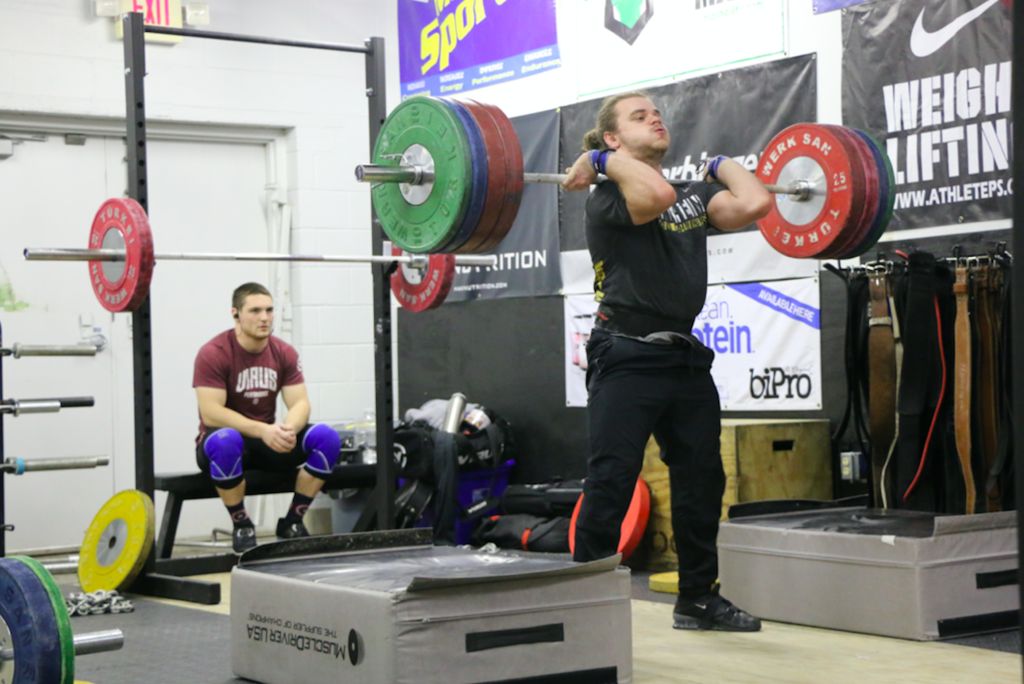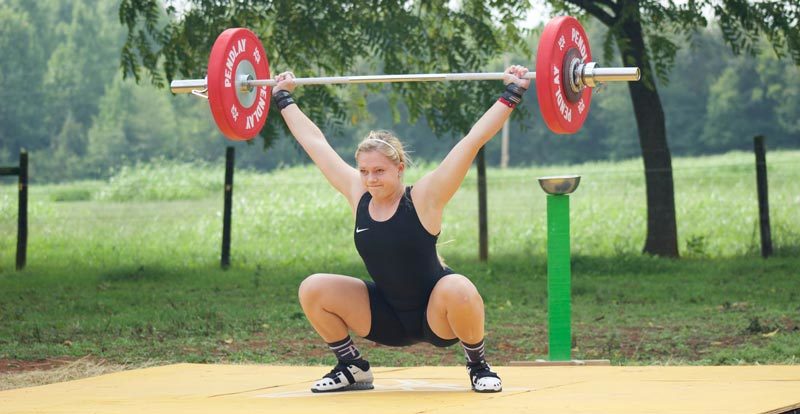I am a huge proponent of teaching the Olympic lifts – the snatch and clean and jerk. They are great movements for sports performance, at times general fitness, and for competitive sport of course.
For sports performance, you get the most bang for your buck when performing these Olympic lifts. For starters, you get a pull, a squat, and an overhead press with one movement versus three separate movements. In a field where time is everything, you can’t beat it. You also get:
- force absorption when you meet the bar during the catch phase.
- power production which is second to none in the weight room.
- kinesthetic awareness as you learn to move around a heavy bar in space.
- mobility because it is required with these movements.
- core stability – especially in the torso as it stabilizes during the pull and catch phase.
If you are coaching general fitness, CrossFit has shown us all that the Olympic movements are great for coaching adults… if the adults are able to perform the movements properly. A simple assessment using the front squat, overhead squat, snatch deadlift, and the strict press will tell you if the athlete is capable of performing the movements. This goes for athletes and general fitness adults. If they can’t perform these four movements, then you probably need to start with teaching them these four movements and helping them improve their movement patterns.
Guys, a 40-year-old accountant who has been strapped to his desk and computer for the last twenty years isn’t prepared to snatch. They might never be prepared to snatch. That’s ok! They can do other movements that will improve their mobility and strength without hurting them. This is part of the main point of this article. As coaches we have to be experts in what we are teaching. If we aren’t experts, then we shouldn’t be teaching.

Last of course, the snatch and clean and jerk are great movements for competitive sport. At Mash, we coach some of the best weightlifters in the world. However, if you want to coach the sport, you dang well better understand the movements and the ins and outs of the sport. FYI there are a lot of ins and outs. Too many athletes get burned out and/or hurt by coaches who simply don’t understand the sport. It never fails, no matter how many ‘how to’ videos and articles I produce, we see rookie coaches who literally have no idea what they are doing at meets.
KNOW YOUR CRAFT
Here’s the main point of this article: If you don’t know how to teach the Olympic lifts, please don’t try and teach them. If you are dead set on teaching them, then take a USA Weightlifting Level 1 Coaching Course and get a foundation. From there, find a mentor near you to shadow and ask questions. I’ve had so many great mentors over the years who have helped me with the lifts – like Coach Sean Waxman, Coach Don McCauley, and Coach Kevin Doherty. Don’t let your ego get in the way. Your athletes deserve better.
I am not talking about specific technique, degree of plantar flexion, or how much to move one’s feet. I will save all of that for a pure weightlifting article. I am talking about teaching the lifts in a way where the athletes will be able to perform the competitive lifts safely and in a manner where the aforementioned benefits will be realized by the athletes. I am going to break the concerns into two categories: Safety concerns and performance concerns.
Safety Concerns
There are four main things I am looking for to determine the safety of the Olympic lifts:
- Properly tracking feet and knees
- Neutral spine
- Safe rack position in the clean
- Safe overhead position in the jerk and snatch
Properly tracking feet and knees: Two days ago I got into a Twitter argument with a lady about a video I posted. I had found a video of one of her athletes on a meme account on Instagram performing the worst clean I have ever seen. First he was performing the clean with some sort of free moving machine, which was the first mistake. Regardless if they were using a machine or a barbell, you always want the athlete pulling, catching, and squatting with knees that track with the first two toes (big toe and pointer toe). Significant amounts of valgus or varus (knees inside the feet or knees outside the feet) are bad for an athlete over time and can cause injury if left untreated. The athlete was demonstrating massive amounts of knee valgus during the pull and the catch phase. The worst part of the whole thing is the coach had no idea they were putting the athlete at risk. One could wonder – what made the coach believe they were qualified to coach athletes? I tried to offer the coach free help to teach them basic biomechanics, but instead of taking me up on the offer she just tried to make excuses and defend their style of training. Coaches – don’t let a silly thing like pride keep you from improving in your chosen craft.
Neutral Spine: Keeping a neutral spine is the most important part of the equation for the safety of the athlete. During a deadlift there is some pretty good evidence that pulling with a flexed thoracic spine will not end up in injury – noting that’s when the athlete begins the pull with a flexed spine and maintains that degree of flexion throughout the pull. When your spine starts moving while in motion and under load – that’s when injury can quickly yield its ugly face. Personally, I have never had any back issues since adhering to the teachings of Dr. Stuart McGill. As far as I know, he’s performed more research on the spine, especially where sport is concerned, than any other scientist of his kind. Therefore, I have to go with neutral spine most of the time with my athletes.
[thrive_leads id=’10395′]
When it comes to the dynamic Olympic lifts, I recommend neutral spine all of the time. If you let your spine flex during the dynamic pull of the snatch or clean, you are asking for a major injury. If your spine flexes during the catch portion, you are putting yourself at significant risk by flexing with a massive load at those speeds.
If you are a sport athlete, you will negate the benefits of force absorption if you catch with a flexed spine. The goal is to teach the athlete to absorb force with a flat back (aka neutral spine), so they can then turn around and deliver the blow to their opponent. If you watch really good rugby players or NFL football players, you will notice their backs never budge during collisions.
Safe rack position in the clean: There are a few necessities when it comes to the rack position in the clean. An athlete will be required to have optimal shoulder protraction and elevation to form the resting position for the bar. The bar will sit behind the front delt and in front of the traps. There is a nice little crevice for the bar to rest in between the delt and trap if the athlete has proper shoulder protraction. The athlete will also be required to have good lat and triceps mobility to allow for proper elbow height as well as good mobility to allow the elbows to get around and up in a quick fashion.
If the athlete can’t get into a good position, they are at risk of hurting their wrists – especially on a mistimed clean – causing the elbows to hit the knees and trapping the bent wrists with the barbell. The collarbones are at risk if the athlete can’t protract and elevate their shoulders. Athletes have actually broken their collarbones over time by not having proper rack positions.

Safe overhead position in the jerk and snatch: If you want to see a bad overhead position in the snatch, simply visit a poorly coached CrossFit. If the coaching staff is forcing all members to snatch, you will see some middle-aged adults trying to snatch with techniques that will make your skin crawl. I am not talking about simply bad technique. I am talking about snatches that are literally risking the orthopedic health of the athletes with each and every repetition.
EVALUATING WHEN WE SHOULD NOT TEACH
I’ve got news for you all. Some people are never going to perform a proper snatch. If they have been working at a desk for the last twenty years and have naturally poor movement, they are going to be restricted. Some are never going to get the movement required to snatch, and that’s okay. They simply want to be healthy. It’s our jobs as professionals to help them get healthy without hurting them.
A snatch requires shoulder mobility and spine mobility, especially in the thoracic spine. The scapula will need to move properly as well. The athlete will be required to place the bar at arm’s length somewhere over the ears or slightly behind that line. The athlete will need to maintain a neutral spine and be able to keep their ribcage down. If they can’t keep their ribcage down, they are getting movement from their lumbar spine as opposed to the thoracic spine. The lumbar spine is meant to be stable during loaded movements. When it starts moving under load, an injury is probably going to occur.
[thrive_leads id=’11558′]
For a good coach, there are several other options for adults – like snatch pulls, dumbbell snatches, kettlebell snatches, or snatch pulls from blocks. Meanwhile, you can work on their mobility unloaded in a safe manner. The goal is to have your adults leaving your facility feeling better than when they walked in. They shouldn’t be driving home cringing in pain from snatches they weren’t meant to do.
Some coaches use the excuse that their adults won’t listen to them. I’ve heard coaches say their adults want to do what everyone else is doing, so they grab a bar and start snatching even though their coach had told them not to. My response is for them to be the professional. It’s all about communication. Your athletes/clients have to trust that you have their best interest at heart, and they have to believe you possess the knowledge to best lead them in a direction most suited for them.
Let me be clear on something: I am not just talking to CrossFit coaches working with adults. I am talking to you coaches working with young athletes. If you can’t teach the movement proficiently, then you shouldn’t teach the lifts at all. You can always learn to teach a perfect squat, pull, press, and row. Then you can add in some plyometrics and med ball throws to have a perfect program. The Olympic lifts are only awesome if taught properly.
Let me end by saying the Olympic lifts are great movements. But they are only as good as the coach teaching them. If you are a strength and conditioning coach, put your time in and learn the lifts properly. You can normally find a weightlifting coach in your area who would love to mentor you on the movements. CrossFit coaches – you need to do the same thing. All coaches need to realize not everyone is ready to learn the Olympic lifts. You need to always have regressions in your toolbox. Your athletes trust you, and they believe you have their best interest in mind. It’s up to us meet these expectations.